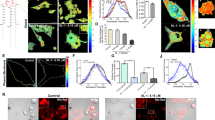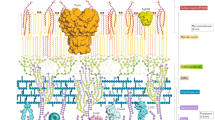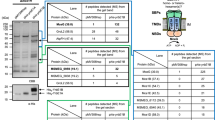Abstract
Mycobacterium tuberculosis infection is a continuing global health crisis that kills 2 million people each year1. Although the structurally diverse lipids of the M. tuberculosis cell envelope each have non-redundant roles in virulence or persistence2,3,4,5,6,7, the molecular mechanisms regulating cell envelope composition in M. tuberculosis are undefined. In higher eukaryotes, membrane composition is controlled by site two protease (S2P)-mediated cleavage of sterol regulatory element binding proteins8,9, membrane-bound transcription factors that control lipid biosynthesis. S2P is the founding member of a widely distributed family of membrane metalloproteases10,11 that cleave substrate proteins within transmembrane segments12. Here we show that a previously uncharacterized M. tuberculosis S2P homologue (Rv2869c) regulates M. tuberculosis cell envelope composition, growth in vivo and persistence in vivo. These results establish that regulated intramembrane proteolysis is a conserved mechanism controlling membrane composition in prokaryotes and show that this proteolysis is a proximal regulator of cell envelope virulence determinants in M. tuberculosis.
This is a preview of subscription content, access via your institution
Access options
Subscribe to this journal
Receive 51 print issues and online access
$199.00 per year
only $3.90 per issue
Buy this article
- Purchase on Springer Link
- Instant access to full article PDF
Prices may be subject to local taxes which are calculated during checkout




Similar content being viewed by others
References
WHO. Global Tuberculosis Control: Surveillance, Planning, Financing (World Health Organization, Geneva, 2004)
Glickman, M. S., Cox, J. S. & Jacobs, W. R. Jr. A novel mycolic acid cyclopropane synthetase is required for cording, persistence, and virulence of Mycobacterium tuberculosis. Mol. Cell 5, 717–727 (2000)
Reed, M. B. et al. A glycolipid of hypervirulent tuberculosis strains that inhibits the innate immune response. Nature 431, 84–87 (2004)
Cox, J. S., Chen, B., McNeil, M. & Jacobs, W. R. Jr. Complex lipid determines tissue-specific replication of Mycobacterium tuberculosis in mice. Nature 402, 79–83 (1999)
Gao, L. Y. et al. Requirement for kasB in Mycobacterium mycolic acid biosynthesis, cell wall impermeability and intracellular survival: implications for therapy. Mol. Microbiol. 49, 1547–1563 (2003)
Dubnau, E. et al. Oxygenated mycolic acids are necessary for virulence of Mycobacterium tuberculosis in mice. Mol. Microbiol. 36, 630–637 (2000)
Rao, V., Fujiwara, N., Porcelli, S. A. & Glickman, M. S. Mycobacterium tuberculosis controls host innate immune activation through cyclopropane modification of a glycolipid effector molecule. J. Exp. Med. 201, 535–543 (2005)
Brown, M. S., Ye, J., Rawson, R. B. & Goldstein, J. L. Regulated intramembrane proteolysis: a control mechanism conserved from bacteria to humans. Cell 100, 391–398 (2000)
Sakai, J. et al. Sterol-regulated release of SREBP-2 from cell membranes requires two sequential cleavages, one within a transmembrane segment. Cell 85, 1037–1046 (1996)
Rawson, R. B. et al. Complementation cloning of S2P, a gene encoding a putative metalloprotease required for intramembrane cleavage of SREBPs. Mol. Cell 1, 47–57 (1997)
Duncan, E. A., Dave, U. P., Sakai, J., Goldstein, J. L. & Brown, M. S. Second-site cleavage in sterol regulatory element-binding protein occurs at transmembrane junction as determined by cysteine panning. J. Biol. Chem. 273, 17801–17809 (1998)
Weihofen, A. & Martoglio, B. Intramembrane-cleaving proteases: controlled liberation of proteins and bioactive peptides. Trends Cell Biol. 13, 71–78 (2003)
Rudner, D. Z., Fawcett, P. & Losick, R. A family of membrane-embedded metalloproteases involved in regulated proteolysis of membrane-associated transcription factors. Proc. Natl Acad. Sci. USA 96, 14765–14770 (1999)
Cutting, S., Roels, S. & Losick, R. Sporulation operon spoIVF and the characterization of mutations that uncouple mother-cell from forespore gene expression in Bacillus subtilis. J. Mol. Biol. 221, 1237–1256 (1991)
Alba, B. M., Leeds, J. A., Onufryk, C., Lu, C. Z. & Gross, C. A. DegS and YaeL participate sequentially in the cleavage of RseA to activate the σE-dependent extracytoplasmic stress response. Genes Dev. 16, 2156–2168 (2002)
Kanehara, K., Ito, K. & Akiyama, Y. YaeL (EcfE) activates the σE pathway of stress response through a site-2 cleavage of anti-σE, RseA. Genes Dev. 16, 2147–2155 (2002)
Chen, J. C., Viollier, P. H. & Shapiro, L. A membrane metalloprotease participates in the sequential degradation of a Caulobacter polarity determinant. Mol. Microbiol. 55, 1085–1103 (2005)
Bardarov, S. et al. Specialized transduction: an efficient method for generating marked and unmarked targeted gene disruptions in Mycobacterium tuberculosis, M. bovis BCG and M. smegmatis. Microbiol. 148, 3007–3017 (2002)
Kuzuyama, T., Takahashi, S., Takagi, M. & Seto, H. Characterization of 1-deoxy-d-xylulose 5-phosphate reductoisomerase, an enzyme involved in isopentenyl diphosphate biosynthesis, and identification of its catalytic amino acid residues. J. Biol. Chem. 275, 19928–19932 (2000)
Altincicek, B. et al. GcpE is involved in the 2-C-methyl-d-erythritol 4-phosphate pathway of isoprenoid biosynthesis in Escherichia coli. J. Bacteriol. 183, 2411–2416 (2001)
Horton, J. D. et al. Combined analysis of oligonucleotide microarray data from transgenic and knockout mice identifies direct SREBP target genes. Proc. Natl Acad. Sci. USA 100, 12027–12032 (2003)
Gilleron, M., Quesniaux, V. F. & Puzo, G. Acylation state of the phosphatidylinositol hexamannosides from Mycobacterium bovis Bacillus Calmette Guérin and Mycobacterium tuberculosis H37Rv and its implication in Toll-like receptor response. J. Biol. Chem. 278, 29880–29889 (2003)
Kremer, L. et al. Characterization of a putative alpha-mannosyltransferase involved in phosphatidylinositol trimannoside biosynthesis in Mycobacterium tuberculosis. Biochem. J. 363, 437–447 (2002)
Cohen-Gonsaud, M. et al. The structure of a resuscitation-promoting factor domain from Mycobacterium tuberculosis shows homology to lysozymes. Nature Struct. Mol. Biol. 12, 270–273 (2005)
Glickman, M. S. & Jacobs, W. R. Jr Microbial pathogenesis of Mycobacterium tuberculosis: dawn of a discipline. Cell 104, 477–485 (2001)
Schaible, U. E. et al. Apoptosis facilitates antigen presentation to T lymphocytes through MHC-I and CD1 in tuberculosis. Nature Med. 9, 1039–1046 (2003)
Rhoades, E. et al. Identification and macrophage-activating activity of glycolipids released from intracellular Mycobacterium bovis BCG. Mol. Microbiol. 48, 875–888 (2003)
Vergne, I. et al. Mycobacterium tuberculosis phagosome maturation arrest: mycobacterial phosphatidylinositol analog phosphatidylinositol mannoside stimulates early endosomal fusion. Mol. Biol. Cell 15, 751–760 (2004)
Hingley-Wilson, S. M., Sambandamurthy, V. K. & Jacobs, W. R. Jr Survival perspectives from the world's most successful pathogen, Mycobacterium tuberculosis. Nature Immunol. 4, 949–955 (2003)
Schobel, S., Zellmeier, S., Schumann, W. & Wiegert, T. The Bacillus subtilis sigmaW anti-sigma factor RsiW is degraded by intramembrane proteolysis through YluC. Mol. Microbiol. 52, 1091–1105 (2004)
Acknowledgements
We thank P. Bongiorno and F. Gao for technical support; V. Rao, N. Serbina, P. Wong and N. Stephanou for discussions; and A. Viale and the Genomics Core Lab of the Memorial Sloan-Kettering Cancer Center for assistance with microarray experiments. M.S.G. is supported by an NIH grant, the Ellison Medical Foundation, and the Speakers Fund for Biomedical Research awarded by the City of New York.
Author information
Authors and Affiliations
Corresponding author
Ethics declarations
Competing interests
Reprints and permissions information is available at npg.nature.com/reprintsandpermissions. The authors declare no competing financial interests.
Supplementary information
Supplementary Figures
This file contains Supplementary Figures S1-S6 and their Supplementary Figure Legends. (PDF 447 kb)
Supplementary Tables
This file contains Supplementary Tables S1 and S2. (PDF 94 kb)
Rights and permissions
About this article
Cite this article
Makinoshima, H., Glickman, M. Regulation of Mycobacterium tuberculosis cell envelope composition and virulence by intramembrane proteolysis. Nature 436, 406–409 (2005). https://doi.org/10.1038/nature03713
Received:
Accepted:
Issue Date:
DOI: https://doi.org/10.1038/nature03713
This article is cited by
-
Iron-related gene mutations driving global Mycobacterium tuberculosis transmission revealed by whole-genome sequencing
BMC Genomics (2024)
-
Lactiplantibacillus plantarum as a novel platform for production and purification of integral membrane proteins using RseP as the benchmark
Scientific Reports (2023)
-
Characterising resuscitation promoting factor fluorescent-fusions in mycobacteria
BMC Microbiology (2018)
-
Understanding HIV-Mycobacteria synergism through comparative proteomics of intra-phagosomal mycobacteria during mono- and HIV co-infection
Scientific Reports (2016)
-
Genomic expression catalogue of a global collection of BCG vaccine strains show evidence for highly diverged metabolic and cell-wall adaptations
Scientific Reports (2015)
Comments
By submitting a comment you agree to abide by our Terms and Community Guidelines. If you find something abusive or that does not comply with our terms or guidelines please flag it as inappropriate.



